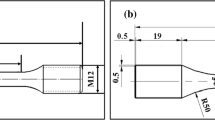Abstract
The relationship between slip character and resistance to cracking under unidirectional and cyclic loading conditions is discussed for single phase solids free of interstitial effects. Under unidirectional loading, increased difficulty of cross-slip intensifies strain within glide bands, induces planar glide, increases the dependence of the yield stress on grain size, and increases the probability of crack formation. In contrast, under cyclic loading, increased difficulty of cross-slip inhibits the slip processes required for crack initiation and growth at a given stress level. A semi-empirical means for predicting the rate of fatigue crack growth is presented.
Résumé
Les relations existant entre les propriétés de déformation par glissement et la réstance aux criques dans des conditions de contrainte unidirectionnelle ou cyclique sont étudiées dans le cas de solides monophasés exempts d' atomes strangers en insertion. Sous charges unidirectionnelles, la difficulte accrue de formation de cross-slips augmente la tension à l' intérieur des bandes de glissement, provoque un glissement plan, accentue la dépendance de la limite élastique sur la grosseur de grain et accroît la probabilité de formation de criques. Par contre, sous charges cycliques, cette même difficulté accrue de formation de crossslips empêche, à un niveau de contraintes donnees, le processus de glissement indispensable à la naissance et au développement de criques. 11 est proposé un moyen semi-empirique de prévoir le taux de croissance des criues de fatigue.
Zusammenfassung
Für einphasige Festkdrper, die frei von Zwischengittereffekten sind, wind die Beziehung zwischen Gleitcharakter and Widerstand gegenüber Ribbildung unter den Bedingungen von Belastung in einer Richtung and zyklischer Belastung diskutiert. Bei Belastung in einer Richtung verstrakt die stark erschwerte Quergleitung die Spannung innerhalb der Gleitbänder, verursacht Ebenen-Gleitung, erhöht die Abhängigkeit der Fliesspannung von der Korngrösse and die Wahrscheinlichkeit der Rissbildung. Bei zyklischer Belastung dagegen verzögert die strak erschwerte Quergleitung solche Gleitprozesse, die zu Bildung and Wachsturn von Rissen notwendig sind. Eine halbempirische Regel für die Vorhersage der Wachstumsgeschwindigkeit von Ermüdungrissen wird angegeben.
Similar content being viewed by others
References
Stokes, R.J. and Li, C.H.Symposium, “Structure and Properties of Engineering Materials,” Raleigh, North Carolina, March, 1962.
Stoloff, N.S., Lezius, D.K. and Johnston T.L. J. Appl. Phys. 34, 3315, 1963.
McEvily, A.J. and Machlin E.S.Fracture, Wiley, New York, 450, 1959.
Boetmer, R.C., and Stoloff, N. S., and Davies, R.G. Trans. AIME (in press).
Stoloff, N.S. and Davies, R. G. Acta Met. 12, 251, 1963.
Stoloff, N.S. and Davies, R.G. and Ku, R., Trans. AIME 253, 1500, 1965.
Boettner, R.C. and McEvily, A. J. Acta Met. 13, 937, 1965.
Swann, P.R. Electron Microscopy and Strength of Crystals, Thomas, G. and Jack Washburn Eds. , Interscience, New York, 1963.
Davies, R.G. and Stoloff, N.S. Phil. Mag. 9, 349, 1964.
Davies, R.G. and Stoloff, N.S. Acta Met. 12, 473, 1964.
Ku, R.C., McEvily, A.J. and Johnston, T.L.Unpublished results.
Thomas, G.J. Australian Inst. of Metals 8, 80, 1963.
Keh, A.S. and Weissman, S. electron Microscopy and the strength of Crystals, Thomas, G. and Jack Washum, Eds., Interscience, New York, 1963.
Lawley, A. and Gaigher, H.L. Phil. Mag. 10, 15, 1964.
Brown, N. and Ekvall, R.A.Acta Met. 10, 1101, 1962.
Armstrong, R., Todd, I., Douthwaite, R.M. Phil. Mag. 7, 45, 1962.
Carnahan, R.D., Johnston, T.L., Stokes, R.J. and Li, C.H., Trans. AIME 221, 45, 1961.
Groves, G.W. and Kelly, A. Phil. Mag. 8, 877, 1963.
Orowan, E. Dislocations in Metals, M. Cohen Ed., AIME, 1954.
MacMahon, C.J. and Cohen, M. Acta Met. 13, 591, 1965.
Johnston, T. L., Davies, R.G. and Stoloff, N.S. Phil. Mag. 12, 305, 1965.
Cottrell, A.H.Trans. AIME 212, 192, 1958.
Cottrell, A.H. Dislocations and Plastic Flow in Crystals, Oxford, 1953.
Perch, N.J. Phil. Mag. 3, 1089, 1958.
Smith, E. and Worthington, P.J.: Int. Conf. on Fracture, Sendai, Japan, 1965.
Forsyth, P.J.E.Proc. of the Crack Propagation Symposium, Cranfield, England 76, 1961.
Wood, W. A. Fracture, Wiley, New York; 412, 1959.
Avery, D.H. and Backofen, W.A. Fracture of Solids, Interscience Publishers, New York, 339, 1963.
McEvily, A.J. and Machlin, E.S. Trans. RIME221, 1086, 1961.
Fegredo, D.M. and Greenough, G.B. Inst. Metals 87, 1, 1958–59.
McEvily, A.J. and Boetmer, R.C. Acta Met. 11, 725, 1963.
Anon. ASM Metals Handbook,American Society for Metals, Metals Park,- Ohio 936, 1961.
Ferro, A. and Montalenti, G. Phil. Mag. 10, 1043, 1961.
Strutt, P.R. J.Australian Inst. of Metals 8, 115, 1963.
Feltner, C.E. Phil. Mag. (in press).
Manson, S.S. Experimental Mechanics 5, 193, 1965.
Morrow, J.D. J. Basic Engineering, Trans ASME, Series D, 87, 275, 1965.
Alden, T. Trans. AIMS 224, 1287, 1962.
Laird, C. and Smith, G.C. Phil. Mag. 7, 847, 1962.
Paris, P.C., Gomez, M.P. and Anderson, W.E. The Trend in Engineering 13, 9, 1961.
McEvily, A.J. and Illg, W.Nat. Advis. Comm. for Aero. , Tn 4394,1958.
Paris, P.C. and Erdogan, F. J. Basic Engineering, Trans. ASME, Series D, 85, 528, 1963.
Weertman, J. Int. Conf. on Fracture, Sendai, Japan, 1965.
McClintock, F.A. Fracture of Solids, Interscience Publishers, New York, 65, 1963.
Krafft, J.M. Applied Materials Research 3, 88, 1964.
Liu, H.W. ibid, 3, 229, 1964.
Bilby, B.A., Cottrell, A.H. and Swinden, K.H. Proc. Roy. Soc. A 272, 304, 1963.
Boettrrer, R.C., Laird, C. and McEvily, A.J. Trans AIMS 223, 386, 1965.
Manson, S.S. Nat. Advis. Comm. for Aero., Tn 2955, 1953.
Coffin, L.F. Trans. ASME 76, 931, 1954.
Laird, C. and Smith, G.C. Phil. Mag. 8, 1945, 1963.
Lutz, G.B. and Wei, R.P. U.S. Steel Appl. Res., Lab. TR, Proj. No. 40112–011(1), July 1961. 53. Munse, W.H. Stallmeyer, J.E. and Rone, J. W. U. of Illinois Report, 1965.
McEvily, A.J. Boettner, R.C. and, Bond, A.P. Inst. Metals 93, 481, 1964–65.
Donaldson, D.R. and Anderson, W. E. Proc. of the Crack Propagation Symposium, Cranfield, England, 375, 1961.
Author information
Authors and Affiliations
Additional information
This paper is a revised version of a paper presented at the International Conference on Fracture, Sendai, Japan, September 1965.
Rights and permissions
About this article
Cite this article
McEvily, A.J., Johnston, T.L. The role of cross-slip in brittle fracture and fatigue. Int J Fract 3, 45–74 (1967). https://doi.org/10.1007/BF00188645
Issue Date:
DOI: https://doi.org/10.1007/BF00188645




